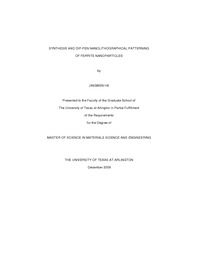
ATTENTION: The works hosted here are being migrated to a new repository that will consolidate resources, improve discoverability, and better show UTA's research impact on the global community. We will update authors as the migration progresses. Please see MavMatrix for more information.
Show simple item record
| dc.contributor.author | He, Jingwen | en_US |
| dc.date.accessioned | 2010-03-03T23:30:40Z | |
| dc.date.available | 2010-03-03T23:30:40Z | |
| dc.date.issued | 2010-03-03T23:30:40Z | |
| dc.date.submitted | January 2009 | en_US |
| dc.identifier.other | DISS-10486 | en_US |
| dc.identifier.uri | http://hdl.handle.net/10106/2050 | |
| dc.description.abstract | Magnetic nanoparticles are of great interest for researchers from a wide range of disciplines, including magnetic fluids, catalysis, biotechnology/biomedicine, magnetic resonance imaging, data storage, and environmental remediation. Ferrites, a class of ferrimagnetic ceramic compounds with the chemical formula of MFe₂O₄, where M represents any one of several metallic elements such as Mg, Fe, Co, Ni, Cu and so on, are commonly used magnetic materials for nanoparticles. Magnetite (Fe3O₄) is the prototype of ferrites. Magnetite nanoparticles have been prepared through the co-precipitation of Fe²⁺ and Fe³⁺ aqueous salt solutions by addition of base. They exhibit a size distribution from 4 nm to 16 nm, showing properties of superparamagnetism. Although co-precipitation is an easy and inexpensive method to prepare magnetite nanoparticles, the control of the particle size becomes the biggest experimental challenge. Centrifugation has been employed as a simple way for size selection. Dip-pen nanolithography (DPN) which was invented in 1999 by Mirkin's group in Northwestern University has been reported as a unique technique with a high resolution for transferring ink molecules on to substrate to create different kinds of micro- or nanostructures. In a typical lithographical experiment, an atomic force microscope (AFM) tip is coated with ink molecules. They are delivered to the surface of a substrate through or over a water meniscus that forms between the tip and the substrate. Water meniscus works as a medium for ink transportation. The self-assembly of ink molecules deposited using DPN can be modeled as a two dimensional diffusion with a source (AFM tip). Dot- and line- features of magnetite nanoparticles within micro- and nanoscale have been generated on 16-mercaptohexadecanoic acid (MHA) patterns created by DPN, giving a precise control of size and position. Dot diameter can be tuned by adjusting the writing time which has a t1/2 dependence (where t is the tipsubstrate contact time). Line width has a linear relationship with the scanning speed. The concentration of suspension of magnetite nanoparticles is crucial for the passivating effect of 1- Octadecanethiol (ODT). The optimum value of concentration of the magnetite nanoparticles suspension has been obtained. | en_US |
| dc.description.sponsorship | Hao, Yaowu | en_US |
| dc.language.iso | EN | en_US |
| dc.publisher | Materials Science & Engineering | en_US |
| dc.title | Synthesis And Dip-pen Nanolithographical Patterning Of Ferrite Nanoparticles | en_US |
| dc.type | M.S. | en_US |
| dc.contributor.committeeChair | Hao, Yaowu | en_US |
| dc.degree.department | Materials Science & Engineering | en_US |
| dc.degree.discipline | Materials Science & Engineering | en_US |
| dc.degree.grantor | University of Texas at Arlington | en_US |
| dc.degree.level | masters | en_US |
| dc.degree.name | M.S. | en_US |
| dc.identifier.externalLink | https://www.uta.edu/ra/real/editprofile.php?onlyview=1&pid=1196 | |
| dc.identifier.externalLinkDescription | Link to Research Profiles | |
Files in this item
- Name:
- HE_uta_2502M_10486.pdf
- Size:
- 6.086Mb
- Format:
- PDF
This item appears in the following Collection(s)
Show simple item record


